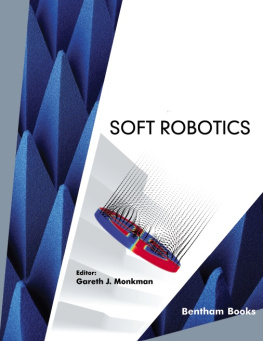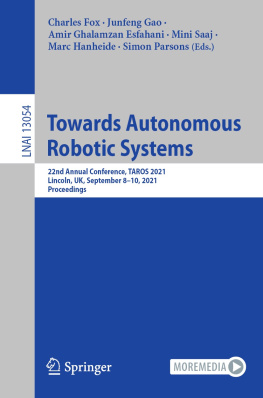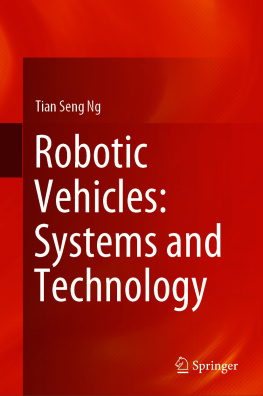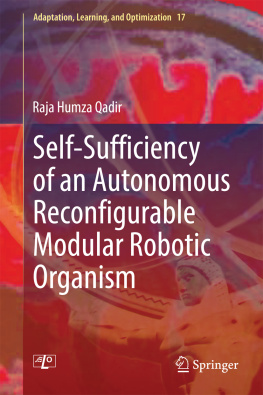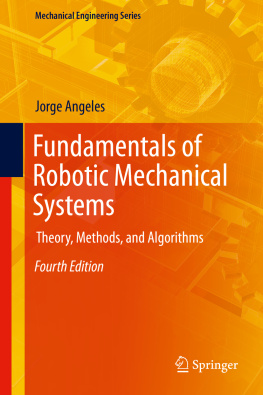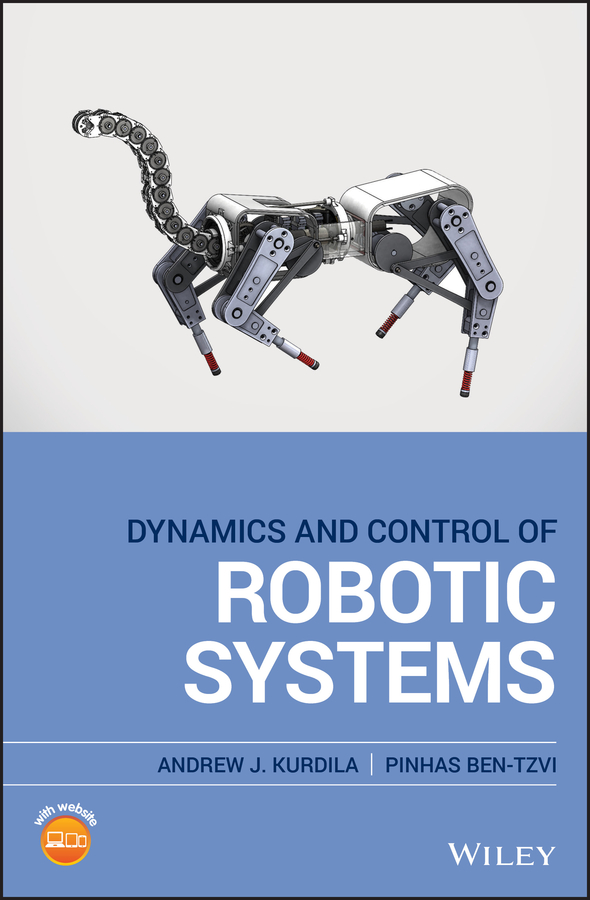
Table of Contents
List of Tables
- Chapter 2
- Chapter 3
- Chapter 5
- Chapter 7
List of Illustrations
- Chapter 1
- Chapter 2
- Chapter 3
- Chapter 4
- Chapter 5
- Chapter 6
- Chapter 7
- Appendix
Guide
Pages
Dynamics and Control of Robotic Systems
Andrew J. Kurdila and Pinhas Ben-Tzvi
Virginia Tech
Virginia
USA

Copyright
This edition first published 2020
2020 John Wiley & Sons Ltd
All rights reserved. No part of this publication may be reproduced, stored in a retrieval system, or transmitted, in any form or by any means, electronic, mechanical, photocopying, recording or otherwise, except as permitted by law. Advice on how to obtain permission to reuse material from this title is available at http://www.wiley.com/go/permissions.
The right of Andrew J. Kurdila and Pinhas BenTzvi to be identified as the authors of this work has been asserted in accordance with law.
Registered Offices
John Wiley & Sons, Inc., 111 River Street, Hoboken, NJ 07030, USA
John Wiley & Sons Ltd, The Atrium, Southern Gate, Chichester, West Sussex, PO19 8SQ, UK
Editorial Office
The Atrium, Southern Gate, Chichester, West Sussex, PO19 8SQ, UK
For details of our global editorial offices, customer services, and more information about Wiley products visit us at www.wiley.com.
Wiley also publishes its books in a variety of electronic formats and by printondemand. Some content that appears in standard print versions of this book may not be available in other formats.
Limit of Liability/Disclaimer of Warranty
MATLAB is a trademark of The MathWorks, Inc. and is used with permission. The MathWorks does not warrant the accuracy of the text or exercises in this book. This work's use or discussion of MATLAB software or related products does not constitute endorsement or sponsorship by The MathWorks of a particular pedagogical approach or particular use of the MATLAB software.
In view of ongoing research, equipment modifications, changes in governmental regulations, and the constant flow of information relating to the use of experimental reagents, equipment, and devices, the reader is urged to review and evaluate the information provided in the package insert or instructions for each chemical, piece of equipment, reagent, or device for, among other things, any changes in the instructions or indication of usage and for added warnings and precautions. While the publisher and authors have used their best efforts in preparing this work, they make no representations or warranties with respect to the accuracy or completeness of the contents of this work and specifically disclaim all warranties, including without limitation any implied warranties of merchantability or fitness for a particular purpose. No warranty may be created or extended by sales representatives, written sales materials or promotional statements for this work. The fact that an organization, website, or product is referred to in this work as a citation and/or potential source of further information does not mean that the publisher and authors endorse the information or services the organization, website, or product may provide or recommendations it may make. This work is sold with the understanding that the publisher is not engaged in rendering professional services. The advice and strategies contained herein may not be suitable for your situation. You should consult with a specialist where appropriate. Further, readers should be aware that websites listed in this work may have changed or disappeared between when this work was written and when it is read. Neither the publisher nor authors shall be liable for any loss of profit or any other commercial damages, including but not limited to special, incidental, consequential, or other damages.
Library of Congress CataloginginPublication Data
Names: Kurdila, Andrew J., author. | Ben-Tzvi, Pinhas, 1973 author.
Title: Dynamics and control of robotic systems / Andrew J. Kurdila, Virginia
Tech, Virginia, USA, Pinhas BenTzvi, Virginia Tech, Virginia, USA.
Description: Hoboken, NJ : Wiley, 2020. | Includes bibliographical references
and index. |
Identifiers: LCCN 2019007284 (print) | LCCN 2019009469 (ebook) | ISBN
9781119524908 (Adobe PDF) | ISBN 9781119524953 (ePub) | ISBN 9781119524830
(hardback)
Subjects: LCSH: Robots-Dynamics. | RobotsControl systems.
Classification: LCC TJ211.4 (ebook) | LCC TJ211.4 .K87 2020 (print) | DDC
629.8/92dc23
LC record available at https://lccn.loc.gov/2019007284
Cover Design: Wiley
Cover Image: Pinhas BenTzvi
Dedication
This book is dedicated to Patrick, Hannah
and Justin, and to Timor, Jonathan, Daniel,
and Sara
Preface
The goal of this book is to provide a modern, systematic, and thorough theoretical background for the study of the dynamics and control of robotic systems. The presentation of the material emphasizes the underlying principles of dynamics and control that can be employed in a host of contemporary applications. Consequently, at its core, the goal of this book is quite ambitious. Not only do we seek to give a detailed presentation of the precepts of robotics, but also we aim to provide methodologies that are applicable to realistic robotic systems. These robotic systems include the following well known examples: classical industrial manipulators, humanoid robots, autonomous ground vehicles, autonomous air vehicles, autonomous marine vehicles, robotic surgical assistants, space vehicles, and computer controlled milling machines. Modern robotic systems are inherently complex, and the representation of their dynamics and the synthesis of their control can be unavoidably complicated.
One of the principal reasons for creating this book has been to show how modern computational and analytical tools expand and enhance our ability to address problems in robotics. Even a few years ago, the complexity of modern robotic systems rendered intractable the solution by hand of all but the most simple examples. The formulation of dynamic models of common robotic systems was once too tedious for the classroom. The advent of symbolic, numeric, and general purpose computational engines over the past few decades is particularly relevant to the problems addressed in this book. With higher level computing environments such as MATLAB, Mathematica, Maple and similar programs, the envelope of problems that can be addressed by undergraduate and graduate students has expanded dramatically. These tools enable students to focus on principles and theory, and free them from tedious exercises in algebraic gymnastics that merely distract from the technical foundations. It is critical, in our opinion, that the student concentrates on the systematic application of the underlying principles.
This text evolved from class notes and problem assignments for courses in dynamics, control, and robotics taught by the authors over a period of several years. These courses have been taught at several top tier universities in the United States, and our approach in presenting the material has continuously evolved during this time. This material is suitable for a two semester sequence in dynamics, control, and robotics at the senior undergraduate or first year graduate student level. A course intended for the senior year of an undergraduate curriculum can focus on the fundamentals of kinematics and dynamics as applied to robotic systems. This first semester can be built primarily from topics extracted from Chapters 2, 3, and 4, and to a lesser degree from Chapter 5. A second semester can concentrate on the techniques of analytical mechanics in Chapter 5 and control theory in Chapter 6. Specific advanced topics such as the recursive order
Next page

